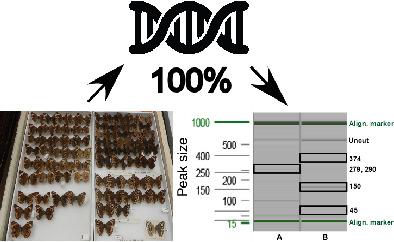当前位置:
X-MOL 学术
›
Syst. Entomol.
›
论文详情
Our official English website, www.x-mol.net, welcomes your
feedback! (Note: you will need to create a separate account there.)
How old can we go? Evaluating the age limit for effective DNA recovery from historical insect specimens
Systematic Entomology ( IF 4.7 ) Pub Date : 2019-12-02 , DOI: 10.1111/syen.12411 Melanie M.L. Lalonde 1 , Jeffrey M. Marcus 1
Systematic Entomology ( IF 4.7 ) Pub Date : 2019-12-02 , DOI: 10.1111/syen.12411 Melanie M.L. Lalonde 1 , Jeffrey M. Marcus 1
Affiliation

|
Historical museum specimens are valuable for exploring population genetics and evolutionary questions because they can provide snapshots of morphological and genetic characteristics from populations over space and time. Unfortunately, DNA found in older museum specimens is frequently degraded, so obtaining genotypes from many individual samples necessary for rigorous molecular population genetic studies is challenging. Previous studies have varied greatly in their success at obtaining genotypes from older preserved insect material. Many well‐intentioned collection curators have used research results showing poor preservation of DNA preserved in museum specimens to inform curatorial best practices, in some cases choosing not to allow DNA extraction by destructive sampling because, in their estimation, the likelihood of success would be low. Recent methodological advances in DNA extraction, amplification, and genotyping have allowed some researchers to include mid‐19th century samples in molecular genetic analyses. Here we present a robust, high‐throughput, and low‐cost DNA extraction and genotyping protocol for historical insect specimens employing restriction digests of PCR products followed by high sensitivity electrophoresis. Using this technique, we obtained mitochondrial haplotypes for 100% of 48 New World Junonia butterfly specimens (Nymphalidae) ranging in age from pre‐1813 to 1909 and show that the haplotype frequencies obtained are statistically indistinguishable from 20th‐century and contemporary reference populations of Junonia (1632 specimens) matched by geographic region. As most extant insect specimens were collected after 1813, based on our findings we would expect that many or even most pinned specimens preserved in museum collections contain usable DNA for mitochondrial haplotyping.
中文翻译:

我们几岁可以去?评估从历史昆虫标本中有效回收 DNA 的年龄限制
历史博物馆标本对于探索种群遗传学和进化问题很有价值,因为它们可以提供种群在空间和时间上的形态和遗传特征的快照。不幸的是,在较旧的博物馆标本中发现的 DNA 经常被降解,因此从许多个体样本中获得严格的分子群体遗传研究所需的基因型具有挑战性。以前的研究在从较旧的保存昆虫材料中获得基因型方面取得了很大的成功。许多善意的收藏馆长利用研究结果表明,博物馆标本中保存的 DNA 保存不佳,以告知馆长最佳实践,在某些情况下,选择不允许通过破坏性采样提取 DNA,因为据他们估计,成功的可能性很低. 最近在 DNA 提取、扩增和基因分型方面的方法学进步使一些研究人员能够将 19 世纪中叶的样本纳入分子遗传分析。在这里,我们提出了一种稳健、高通量、低成本的 DNA 提取和基因分型方案,用于历史昆虫标本,采用 PCR 产物的限制性消化,然后进行高灵敏度电泳。使用这种技术,我们获得了 100% 年龄从 1813 年到 1909 年之间的新世界 Junonia 蝴蝶标本(蛱蝶科)的线粒体单倍型,并表明获得的单倍型频率与 20 世纪和当代的 Junonia 参考种群在统计上无法区分(1632 个样本)按地理区域匹配。由于大多数现存的昆虫标本是在 1813 年之后收集的,
更新日期:2019-12-02
中文翻译:

我们几岁可以去?评估从历史昆虫标本中有效回收 DNA 的年龄限制
历史博物馆标本对于探索种群遗传学和进化问题很有价值,因为它们可以提供种群在空间和时间上的形态和遗传特征的快照。不幸的是,在较旧的博物馆标本中发现的 DNA 经常被降解,因此从许多个体样本中获得严格的分子群体遗传研究所需的基因型具有挑战性。以前的研究在从较旧的保存昆虫材料中获得基因型方面取得了很大的成功。许多善意的收藏馆长利用研究结果表明,博物馆标本中保存的 DNA 保存不佳,以告知馆长最佳实践,在某些情况下,选择不允许通过破坏性采样提取 DNA,因为据他们估计,成功的可能性很低. 最近在 DNA 提取、扩增和基因分型方面的方法学进步使一些研究人员能够将 19 世纪中叶的样本纳入分子遗传分析。在这里,我们提出了一种稳健、高通量、低成本的 DNA 提取和基因分型方案,用于历史昆虫标本,采用 PCR 产物的限制性消化,然后进行高灵敏度电泳。使用这种技术,我们获得了 100% 年龄从 1813 年到 1909 年之间的新世界 Junonia 蝴蝶标本(蛱蝶科)的线粒体单倍型,并表明获得的单倍型频率与 20 世纪和当代的 Junonia 参考种群在统计上无法区分(1632 个样本)按地理区域匹配。由于大多数现存的昆虫标本是在 1813 年之后收集的,











































 京公网安备 11010802027423号
京公网安备 11010802027423号